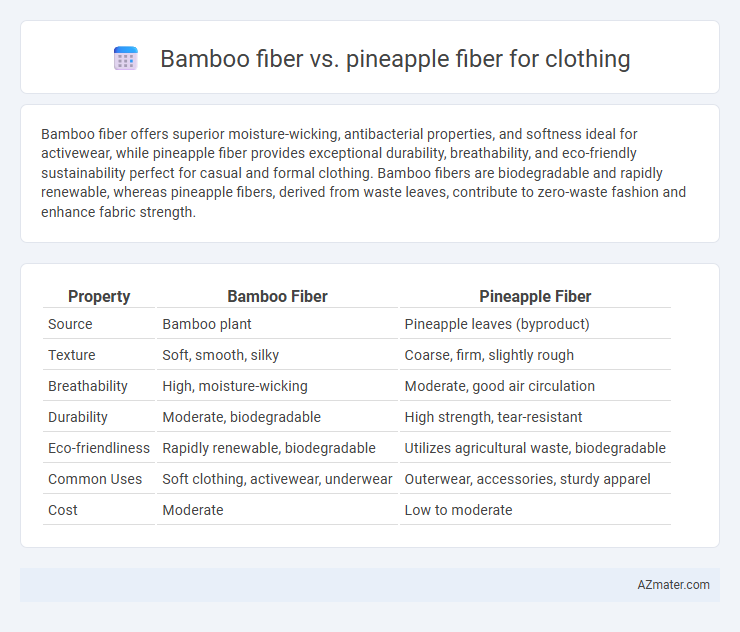Bamboo fiber offers superior moisture-wicking, antibacterial properties, and softness ideal for activewear, while pineapple fiber provides exceptional durability, breathability, and eco-friendly sustainability perfect for casual and formal clothing. Bamboo fibers are biodegradable and rapidly renewable, whereas pineapple fibers, derived from waste leaves, contribute to zero-waste fashion and enhance fabric strength.
Table of Comparison
| Property | Bamboo Fiber | Pineapple Fiber |
|---|---|---|
| Source | Bamboo plant | Pineapple leaves (byproduct) |
| Texture | Soft, smooth, silky | Coarse, firm, slightly rough |
| Breathability | High, moisture-wicking | Moderate, good air circulation |
| Durability | Moderate, biodegradable | High strength, tear-resistant |
| Eco-friendliness | Rapidly renewable, biodegradable | Utilizes agricultural waste, biodegradable |
| Common Uses | Soft clothing, activewear, underwear | Outerwear, accessories, sturdy apparel |
| Cost | Moderate | Low to moderate |
Introduction to Natural Fibers in Sustainable Fashion
Bamboo fiber and pineapple fiber are prominent natural fibers utilized in sustainable fashion due to their eco-friendly properties and renewability. Bamboo fabric boasts exceptional softness, moisture-wicking, and antimicrobial qualities, making it a popular choice for activewear and casual clothing. Pineapple fiber, derived from pineapple leaf waste, offers strong, breathable textiles often used in eco-conscious apparel and accessories, contributing to a circular economy by reducing agricultural waste.
Overview of Bamboo Fiber for Clothing
Bamboo fiber is a sustainable textile material derived from the pulp of bamboo plants, valued for its natural antibacterial properties and exceptional breathability, making it ideal for activewear and sensitive skin. It offers high moisture-wicking capabilities and a soft, silky texture comparable to cotton or silk, enhancing comfort in clothing applications. Rapidly renewable and biodegradable, bamboo fiber supports eco-friendly fashion while providing durability and ease of dyeing for versatile garment designs.
Properties and Benefits of Pineapple Fiber Fabric
Pineapple fiber fabric, derived from the leaves of the pineapple plant through sustainable extraction methods, offers exceptional breathability, moisture-wicking properties, and natural antimicrobial qualities that make it highly suitable for clothing. Its lightweight yet durable texture provides excellent comfort and longevity, while the eco-friendly production process reduces environmental impact compared to synthetic fibers. The fabric's ability to retain vivid color and resist wrinkles further enhances its appeal for fashion and activewear applications.
Environmental Impact: Bamboo vs Pineapple Fiber Production
Bamboo fiber production is often praised for its rapid growth rate and minimal pesticide use, making it a renewable resource with a relatively low environmental footprint. Pineapple fiber, extracted from agricultural waste such as pineapple leaves, promotes waste valorization and reduces reliance on synthetic fibers, contributing to circular economy principles. Both fibers require less water and chemicals compared to conventional cotton, but pineapple fiber's utilization of byproducts offers a unique advantage in reducing overall agricultural waste.
Texture, Comfort, and Wearability Comparison
Bamboo fiber offers a silky, smooth texture with excellent breathability, making it highly comfortable for clothing and ideal for sensitive skin due to its natural hypoallergenic properties. Pineapple fiber, derived from pineapple leaves, provides a coarser texture but is lightweight and durable, lending well to structured garments and sustainable fashion. Both fibers excel in wearability, with bamboo excelling in moisture-wicking and softness, while pineapple fiber stands out for its toughness and eco-friendly appeal.
Durability and Care Requirements
Bamboo fiber offers high durability with natural antimicrobial properties that reduce odors and prolong garment life, requiring gentle washing to maintain softness. Pineapple fiber, known as pina, is strong but more delicate due to its fine texture, demanding hand washing or mild cycles to prevent damage. Both fibers benefit from air drying and avoidance of harsh chemicals to preserve fabric integrity and longevity.
Moisture-Wicking and Breathability Features
Bamboo fiber excels in moisture-wicking due to its natural micro-gaps that efficiently absorb and evaporate sweat, making it highly breathable and comfortable for activewear. Pineapple fiber, derived from leaves, offers moderate moisture-wicking properties with superior durability and a slightly coarser texture, enhancing airflow but providing less softness compared to bamboo. Both fibers are sustainable options, yet bamboo's exceptional breathability and moisture management make it more suitable for garments requiring lightweight, quick-drying fabrics.
Dyeing and Color Retention Capabilities
Bamboo fiber exhibits strong dye uptake due to its smooth surface and high absorbency, resulting in vibrant colors that maintain brightness over multiple washes. Pineapple fiber, composed of coarse cellulose, absorbs dye less uniformly, leading to slightly muted tones but offers excellent colorfastness because of its natural fiber structure. Both fibers differ in dye affinity, with bamboo favoring reactive dyes for vivid shades and pineapple better suited to natural or vat dyes for long-lasting color retention in clothing.
Cost and Accessibility for Consumers
Bamboo fiber offers a cost-effective option for clothing due to its rapid growth cycle and widespread cultivation, leading to lower raw material prices and increased accessibility in global markets. Pineapple fiber, derived from pineapple leaf waste, is generally more expensive because of its limited production scale and labor-intensive extraction process, making it less accessible for mass-market consumers. Consumers seeking affordable sustainable fabrics often prefer bamboo fiber, while pineapple fiber is favored for niche, premium eco-friendly apparel.
Final Verdict: Which Fiber is Better for Sustainable Clothing?
Bamboo fiber offers superior moisture-wicking properties and natural antibacterial benefits, making it ideal for activewear and sensitive skin. Pineapple fiber, derived from pineapple leaves, provides exceptional durability and breathability, contributing to long-lasting, eco-friendly garments. For sustainable clothing, pineapple fiber edges ahead due to its use of agricultural waste and minimal water requirements, supporting a lower environmental footprint.

Infographic: Bamboo fiber vs Pineapple fiber for Clothing
 azmater.com
azmater.com